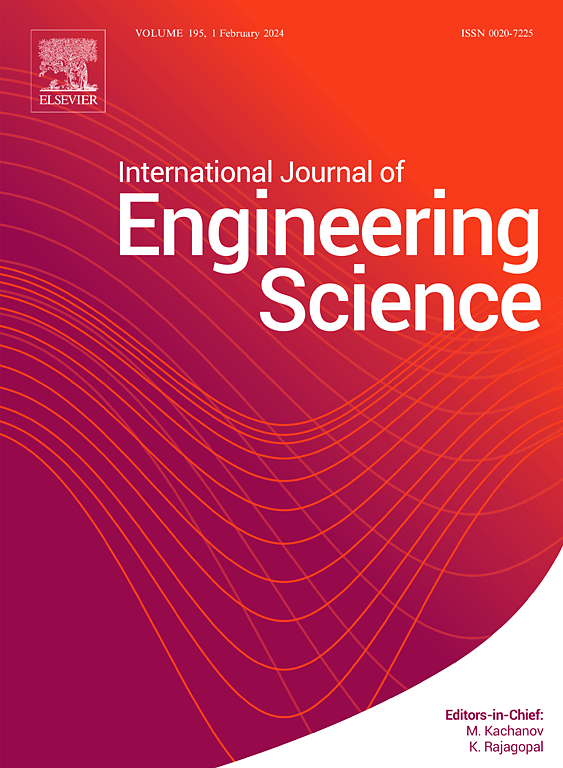Torsional vibration of a coupled cylinder
IF 5.7
1区 工程技术
Q1 ENGINEERING, MULTIDISCIPLINARY
International Journal of Engineering Science
Pub Date : 2025-09-09
DOI:10.1016/j.ijengsci.2025.104374
引用次数: 0
Abstract
The torsion loading of a coupled cylinder, comprising distinct upper and lower cylindrical sections potentially made of different materials, is considered. The bottom of the cylinder is fixed in place, and induces the cylinder vibration. The torsion is applied via an arbitrary loading on the upper face. Three forms of coupling condition between the upper and lower cylinders are outlined: ideal, soft (weak), and rigid (hard/ stiff) contact. The resulting displacements and tangential stresses are obtained using the finite Hankel transform, and a Green’s function representation of the displacement. Numerical results are provided, and the impact of the differing coupling conditions investigated for a range of cylinder geometries, material properties and vibration rates. The resonance frequencies of the coupled cylinder are determined. A method for using the coupled cylinder model to approximate the displacement of a cylinder containing a damaged region via a weak interfacial layer is outlined. The properties of the weak interface layer needed for this approximation are determined, and the advantages of its use in non-destructive testing are discussed.
耦合圆柱的扭转振动
考虑了一个耦合圆柱体的扭转载荷,该圆柱体包括不同的上下圆柱体部分,可能由不同的材料制成。气缸底部固定到位,引起气缸振动。扭转是通过上表面的任意载荷施加的。概述了上下气缸之间的三种形式的耦合条件:理想、软(弱)和刚性(硬/硬)接触。利用有限汉克尔变换和位移的格林函数表示得到了位移和切向应力。给出了数值结果,并研究了不同耦合条件对一系列圆柱体几何形状、材料性能和振动速率的影响。确定了耦合圆柱的谐振频率。提出了一种利用耦合柱体模型通过弱界面层逼近含有损伤区域的柱体位移的方法。确定了这种近似所需的弱界面层的性质,并讨论了其在无损检测中的优点。
本文章由计算机程序翻译,如有差异,请以英文原文为准。
求助全文
约1分钟内获得全文
求助全文
来源期刊

International Journal of Engineering Science
工程技术-工程:综合
CiteScore
11.80
自引率
16.70%
发文量
86
审稿时长
45 days
期刊介绍:
The International Journal of Engineering Science is not limited to a specific aspect of science and engineering but is instead devoted to a wide range of subfields in the engineering sciences. While it encourages a broad spectrum of contribution in the engineering sciences, its core interest lies in issues concerning material modeling and response. Articles of interdisciplinary nature are particularly welcome.
The primary goal of the new editors is to maintain high quality of publications. There will be a commitment to expediting the time taken for the publication of the papers. The articles that are sent for reviews will have names of the authors deleted with a view towards enhancing the objectivity and fairness of the review process.
Articles that are devoted to the purely mathematical aspects without a discussion of the physical implications of the results or the consideration of specific examples are discouraged. Articles concerning material science should not be limited merely to a description and recording of observations but should contain theoretical or quantitative discussion of the results.
 求助内容:
求助内容: 应助结果提醒方式:
应助结果提醒方式:


